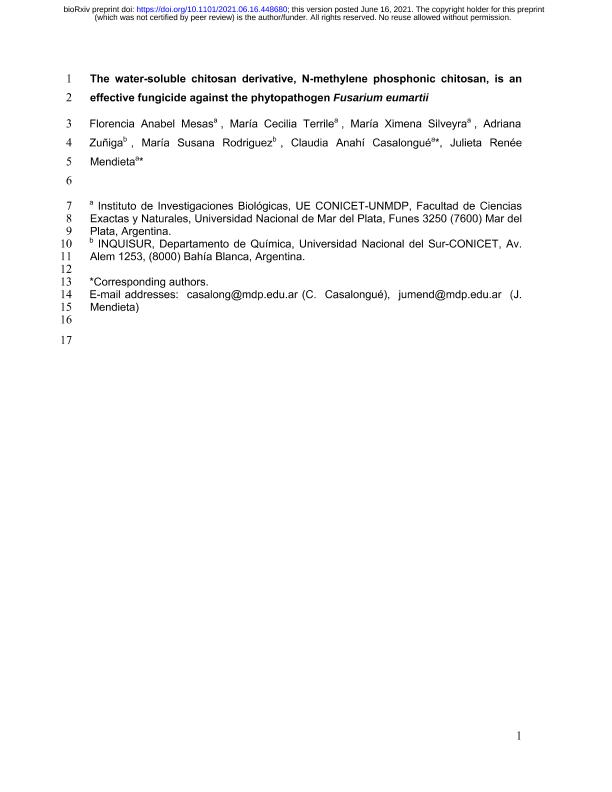Artículo
The water-soluble chitosan derivative, N-methylene phosphonic chitosan, is an effective fungicide against the phytopathogen Fusarium eumartii
Mesas, Florencia Anabel ; Terrile, Maria Cecilia
; Terrile, Maria Cecilia ; Silveyra, María Ximena
; Silveyra, María Ximena ; Zuñiga, Adriana Elena; Rodriguez, Maria Susana; Casalongue, Claudia
; Zuñiga, Adriana Elena; Rodriguez, Maria Susana; Casalongue, Claudia ; Mendieta, Julieta Renee
; Mendieta, Julieta Renee
 ; Terrile, Maria Cecilia
; Terrile, Maria Cecilia ; Silveyra, María Ximena
; Silveyra, María Ximena ; Zuñiga, Adriana Elena; Rodriguez, Maria Susana; Casalongue, Claudia
; Zuñiga, Adriana Elena; Rodriguez, Maria Susana; Casalongue, Claudia ; Mendieta, Julieta Renee
; Mendieta, Julieta Renee
Fecha de publicación:
06/2021
Editorial:
Korean Soc Plant Pathology
Revista:
Plant Pathology Journal
ISSN:
2692-8205
e-ISSN:
1598-2254
Idioma:
Inglés
Tipo de recurso:
Artículo publicado
Clasificación temática:
Resumen
Chitosan has been considered an environmental-friendly polymer. However, its use in agriculture has not been extended yet due to its relatively low solubility in water. In an attempt to improve such chemical characteristics, a chitosan-derivative prepared by adding a phosphonic group to chitosan N-methylene phosphonic chitosan, NMPC, was obtained from shrimp fishing industry waste from Argentinean Patagonia. This study showed that NMPC had a fungicidal effect on the phytopathogenic fungus Fusarium solani f. sp. eumartii (F. eumartii). NMPC inhibited F. eumartti mycelial growth and spore germination with low IC50 values. In vivo studies showed that NMPC affected fungal membrane permeability, ROS production, and cell death. NMPC also exerted antifungal effects against two other phytopathogens, Botrytis cinerea, and Phytophthora infestans. NMPC did not affect tomato cell viability at the same doses applied to these phytopathogens. Furthermore, the selective cytotoxicity of NMPC could give it added value in its application as an antimicrobial agent in agriculture.
Palabras clave:
ANTIFUGAL ACTIVITY
,
FUSARIUM SOLANI
,
NMPC
,
SOLANUM LYCOPERSICUM
Archivos asociados
Licencia
Identificadores
Colecciones
Articulos(IIB)
Articulos de INSTITUTO DE INVESTIGACIONES BIOLOGICAS
Articulos de INSTITUTO DE INVESTIGACIONES BIOLOGICAS
Articulos(INQUISUR)
Articulos de INST.DE QUIMICA DEL SUR
Articulos de INST.DE QUIMICA DEL SUR
Citación
Mesas, Florencia Anabel; Terrile, Maria Cecilia; Silveyra, María Ximena; Zuñiga, Adriana Elena; Rodriguez, Maria Susana; et al.; The water-soluble chitosan derivative, N-methylene phosphonic chitosan, is an effective fungicide against the phytopathogen Fusarium eumartii; Korean Soc Plant Pathology; Plant Pathology Journal; 6-2021; 1-25
Compartir
Altmétricas



